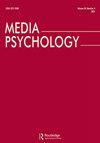Something that They Never Said: Multimodal Disinformation and Source Vividness in Understanding the Power of AI-Enabled Deepfake News
IF 2.6
2区 心理学
Q1 COMMUNICATION
引用次数: 18
Abstract
ABSTRACT While deepfake has emerged as a severe issue in the multimedia environment, most studies examined text-based false claims, leaving the question of what unique features of video-based deepfake news deceives recipients and how it can be corrected. By conducting two online experiments, we study perceived source vividness as a psychological mechanism of the effect of AI-enabled deepfake news on news credibility and engagement intentions. Furthermore, we test how an inserted false-tag onto the fake news can reduce the impact of source vividness experienced by seeing multimodal disinformation on news credibility and engagement intentions. The results suggest that participants who saw deepfake news had higher source vividness than those who saw fake news with other modalities (i.e., text-only and text-photo), and such source vividness increased credibility and engagement intentions of fake news. The false-tag successfully reduced engagement intentions of deepfake news for those who perceived a high vividness of the superimposed interviewee.他们从未说过的话:在理解人工智能深度假新闻的力量时,多模式的虚假信息和来源的生动性
虽然深度假新闻在多媒体环境中已经成为一个严重的问题,但大多数研究都研究了基于文本的虚假声明,留下了基于视频的深度假新闻欺骗接收者的独特特征以及如何纠正的问题。通过进行两个在线实验,我们研究了感知源生动性作为人工智能支持的深度假新闻对新闻可信度和参与意愿影响的心理机制。此外,我们测试了在假新闻上插入假标签如何通过看到多模态虚假信息来减少源生动性对新闻可信度和参与意图的影响。结果表明,看到深度假新闻的参与者比看到其他形式的假新闻(即纯文字和文字图片)的参与者具有更高的源生动性,并且这种源生动性增加了假新闻的可信度和参与意愿。对于那些认为叠加的受访者非常生动的人来说,假标签成功地降低了深度假新闻的参与意愿。
本文章由计算机程序翻译,如有差异,请以英文原文为准。
求助全文
约1分钟内获得全文
求助全文
来源期刊

Media Psychology
Multiple-
CiteScore
8.60
自引率
7.10%
发文量
30
期刊介绍:
Media Psychology is an interdisciplinary journal devoted to publishing theoretically-oriented empirical research that is at the intersection of psychology and media communication. These topics include media uses, processes, and effects. Such research is already well represented in mainstream journals in psychology and communication, but its publication is dispersed across many sources. Therefore, scholars working on common issues and problems in various disciplines often cannot fully utilize the contributions of kindred spirits in cognate disciplines.
 求助内容:
求助内容: 应助结果提醒方式:
应助结果提醒方式:


